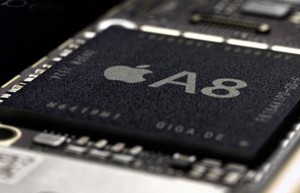Chinese sources, report that the A8 processor chip, which is to be the next advance in Apple Inc.’s (NASDAQ:AAPL) system architecture, features a dual core setup rather than the quad core predicted for months by many sources. It was believed that Apple was moving to a four core chip setup thanks to increased miniaturization. Though the two core arrangement is not as innovative as a quad setup, it is said to muster impressive performance.
Despite having only two cores, the A8 processor will benefit from 20 nanometer process technology as opposed to the 28 nanometer process used in the current A7 core. This will boost processor speed to a level in excess of 2.0 gigahertz (GHz), which is a major jump from the A7’s performance. The A7, which already makes Apple Inc. (AAPL) an industry leader, can muster only 1.4 GHz in an iPad, and slightly less at 1.3 GHz when built into the iPhone form factor.
 The A7 is already more advanced than the apps it is designed to run, with none of those currently available capable of testing its limits. The A8 will boost performance even further, though some of this extra bandwidth will doubtless be siphoned off by the extra demands of larger smartphone screens due to be introduced with the groundbreaking iPhone 6.
The A7 is already more advanced than the apps it is designed to run, with none of those currently available capable of testing its limits. The A8 will boost performance even further, though some of this extra bandwidth will doubtless be siphoned off by the extra demands of larger smartphone screens due to be introduced with the groundbreaking iPhone 6.
The A8 processor chip is being partially supplied by Taiwan Semiconductor Manufacturing Company, or TSMC (NYSE:TSM). This firm produces 20 nanometer process technology which, according to the company’s foundry page, surpasses 28 nanometer technology in at least three crucial regards. The 20 nanometer process increases speed by a full 30%, which helps explain the 2.0+ GHz promised from the A8 chip. Furthermore, its density is 190% of 28 nanometer chips and energy use is slashed by 25%.
Much of the new architecture used for 20 nanometer process semiconductors is based on trial and error data earned from the 28 nanometer process. The 20 nanometer process, in turn, will pave the way for 16 nanometer process tech in next year’s A9 chip.
Apple (AAPL) is in the intriguing position of currently building technology that no company yet has the products to make the best use of. Current apps and programs use far less processing power than either the A7 or A8 chip provide. However, it is only a matter of time until a new wave of software arrives, and with its current “overkill,” Apple will be well positioned to support that fresh approach, whatever it ultimately proves to be.



